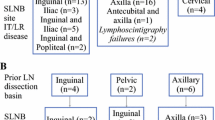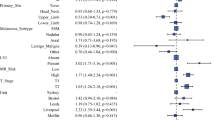Abstract
Background: Regional lymph node tumor volumes in patients undergoing sentinel lymph node (SN) biopsy (SNB) for treatment of cutaneous melanoma have not been described. The objectives of this study were to describe the lymph node tumor volumes typically seen in this population and to correlate tumor volumes with tumor thickness and positive SN characteristics.
Methods: Review of a consecutive series of patients with clinically localized cutaneous melanoma who underwent SNB of nonpalpable regional lymph node basins followed by complete lymphadenectomy (LND) was performed. Multiple lymph node sections from positive SNs and nonsentinel nodes (NSNs) in LND specimens were examined microscopically. Individual tumor deposit diameters were measured using an ocular micrometer. Aggregate tumor volumes were calculated for SN and LND specimens. Tumor volumes and SN and LND positivity rates were correlated with tumor thickness, the number of positive SNs, and the presence of multiple SN tumor deposits.
Results: SNB procedures were performed for 149 melanomas in 189 regional nodal basins. The mean tumor depth was 2.48 mm. The mean number of SNs/basin was 2.1. Thirty-two of 149 SNB procedures (21.5%) revealed a total of 34 nodal basins with at least one positive SN. The median tumor volume in positive SNs was 4.7 mm3 (range, 0.1-3618 mm3; mean, 209 mm3). The median aggregate tumor volume in positive LND specimens was 4.9 mm3 (range, 0.1-3618 mm3; mean, 224 mm3). Six basins (17.6%) contained at least one positive NSN. The regional node aggregate tumor volume correlated weakly with tumor thickness (Pearson’s correlation coefficient = .302, P = .0934). NSN positivity was not predicted by tumor thickness, American Joint Committee on Cancer tumor stage, number of positive SNs, or number of metastatic deposits within SNs.
Conclusions: Most melanoma-positive SNs contain minute tumor volumes. Tumor thickness and patterns of SN metastases may not be predictive of tumor burden or the presence of positive NSNs.
Similar content being viewed by others
REFERENCES
Morton DL, Wen DR, Wong JH, et al. Technical details of intraoperative lymphatic mapping for early stage melanoma. Arch Surg 1992;127:392–399.
Reintgen D, Cruse CW, Wells K, et al. The orderly progression of melanoma nodal metastases. Ann Surg 1994;220:759–767.
Morton DL, Wen DR, Foshag LJ, et al. Intraoperative lymphatic mapping and selective cervical lymphadenectomy for early stage melanomas of the head and neck. J Clin Oncol 1993;11:1751–1756.
Albertini JJ, Cruse CW, Rapaport D, et al. Intraoperative radiolymphoscintigraphy improves sentinel lymph node identification for patients with melanoma. Ann Surg 1996;223:217–224.
Krag DL, Meijer SJ, Weaver DL, et al. Minimal-access surgery for staging of malignant melanoma. Arch Surg 1995;130:654–658.
Cohen MH, Cetcham AS, Felix EL, et al. Prognostic factors in patients undergoing lymphadenectomy for malignant melanoma. Ann Surg 1977;186:635–642.
Karakousis CP, Seddiq MK, Moore R. Prognostic value of lymph node dissection for malignant melanoma. Arch Surg 1980;115:719–722.
Bevilacqua RG, Coit DG, Rogatko A, et al. Axillary dissection in melanoma: prognostic variables in node-positive patients. Ann Surg 1990;212:125–131.
Buzaid AC, Tinoco LA, Jendiroba D, et al. Prognostic value of size of lymph node metastases in patients with cutaneous melanoma. J Clin Oncol 1995;13:2361–2368.
Gershenwald JE, Mansfield PF, Lee JE, Reintgen DS, Ross MI. Prognostic significance of the sentinel node (SLN) in stage I or II melanoma patients. Melanoma Res 1997;7:S105.
MacKie RM, Byrne D, Lyngam MK, Sajid M, MacKay AK. Prognostic evaluation of sentinel node biopsy. Melanoma Res 1997;7:S102.
Russ JC. Practical stereology. New York: Plenum Press, 1990:62–69.
Heller R, Becker J, Wasselle J, et al. Detection of occult lymph node metastases in malignant melanoma. Ann Plast Surg 1992;28:74–77.
Wang X, Heller R, VanVoorhis N, et al. Detection of submicroscopic lymph node metastases with polymerase chain reaction in patients with malignant melanoma. Ann Surg 1994;220:768–774.
Joseph E, Brobeil A, Glass F, et al. Results of complete lymph node dissection in 83 patients with positive sentinel nodes. Ann Surg Oncol 1998;5:119–125.
Borgstein P, Pijpers R, van Diest P, Meijer S. Staging early lymphatic metastases in melanoma: the case for super-selective lymph node dissection. In: Proceedings of the Society of Surgical Oncology 51st Annual Cancer Symposium, Los Angeles, Society of Surgical Oncology, 1998;P57:63.
Author information
Authors and Affiliations
Rights and permissions
About this article
Cite this article
Wagner, J.D., Davidson, D., Coleman, J.J. et al. Lymph Node Tumor Volumes in Patients Undergoing Sentinel Lymph Node Biopsy for Cutaneous Melanoma. Ann Surg Oncol 6, 398–404 (1999). https://doi.org/10.1007/s10434-999-0398-4
Received:
Accepted:
Issue Date:
DOI: https://doi.org/10.1007/s10434-999-0398-4




